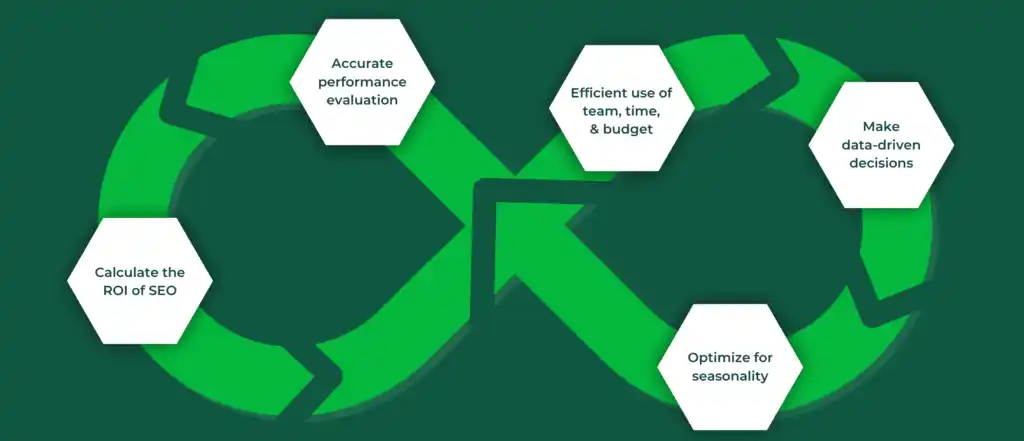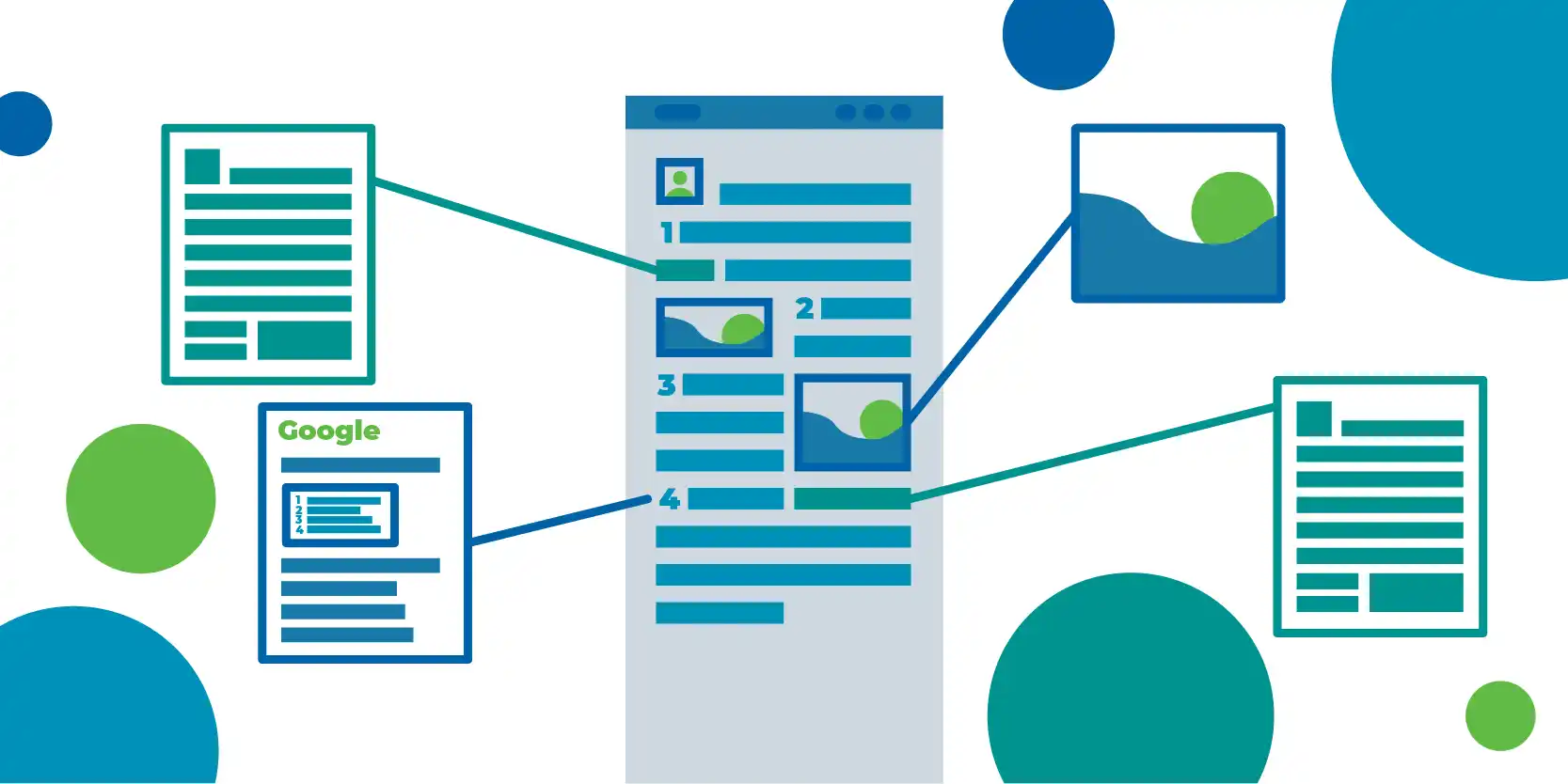
Our sales team spends a considerable amount of time explaining why search engine optimization (SEO) is a critical success component for any brand looking for repeatable bottom-line growth.
Flashy and near-instantaneous acquisition tactics usually get all the attention, but there’s a huge flaw in putting all your eggs in that basket:
Grabbing 100 new customers/leads this week but not being able to replicate that next month is not a formula for sustainable growth. We don’t build client-partner programs that function in this haphazard way.
Sustainability is a core Apiary value, which is why we advocate religiously for SEO and SEO forecasting.
Keep reading to learn:
- What exactly is SEO forecasting?
- What are the benefits of SEO forecasting?
- What are the best forecasting methods?
- Plus, get a free copy of our Apiary SEO Forecasting Tool!
What is SEO forecasting?
SEO forecasting refers to the practice of predicting and projecting future trends, search traffic changes, and other outcomes related to SEO.
By analyzing historical data, current market behavior, and algorithmic patterns, SEO forecasting helps businesses and digital marketers to:
- Anticipate shifts in search engine algorithms and prepare accordingly
- Identify emerging keywords and topics that represent optimization opportunities
- Leverage seasonal fluctuations in monthly search volume
- Make strategic decisions to optimize your site and content
- Stay one step ahead of competition by maximizing organic search performance.
#1 rule of SEO forecasting: Algorithms need humans.
We know, we know. You’ve been reading that headline ^^ everywhere.
We’re not pioneering a revolutionary thought by stating that SEO algorithms need human expertise. Many colleagues and industry leaders have been vocal about the need to balance technological efficiencies with human discernment.
But this sentiment bears repeating because many brands still seem to be under the impression that if math is involved (as is the case with SEO projections), an AI tool should take over.
Here’s why we don’t recommend that particular joyride:
SEO forecasting accuracy can certainly be improved and sped up when AI is used appropriately. But relying on an AI tool by itself? That’s a recipe for disaster.
High-performing SEO forecasting should be conducted by a seasoned subject matter expert with detailed knowledge of your brand and goals.
- What are your primary, secondary, and tertiary KPIs?
- How long is your typical sales cycle?
- Does seasonality impact that cycle?
- Are there any upcoming industry events, product launches, or promotional campaigns that could impact your SEO performance?
- Does your business have a specific goal this quarter and plans to divert attention elsewhere next quarter?
- Are there any external factors (regulatory constraints, known algorithm updates) that could affect your SEO strategy?
Every business is going to answer these questions differently, which is why the “SEO forecasting is pure science” claim is missing the mark.
Like every other aspect of data-informed marketing, context makes all the difference.
SEO forecasting is a truck load of science, but without the human artistry contextualizing that data, the science alone won’t fly.

Our response to: “I need fast acquisition. I don’t have time for SEO.”
We say this with all the respect in the world…
If you’re hyper-focused on acquisition over everything else, you’re missing an understanding of the role that Google algorithms play in any acquisition model.
A singular emphasis on acquisition is tantamount to vaporware, which can’t be codified, and any fast acquisition strategy has to be codified.
Paid and organic content is penalized whether your SEO domain authority is moderately underperforming or failing wildly (the latter happens far more frequently than you’d imagine).
Saying that acquisition and SEO are wholly separate entities is just…wrong.
So, what are the benefits of SEO forecasting?
Benefit #1: Build an SEO strategy on verifiable data
SEO efforts can be time consuming and costly, which is why we believe that every action taken should be validated by clean and trustworthy data.
SEO forecasting is a prioritization and planning tool that draws data-driven performance conclusions, which leads us to benefit #2…
Benefit #2: Efficiently allocate SEO resources
Ranking on the first page (top 3 spots, ideally) of search engine results is not simply a matter of flipping the SEO switch and seconds later, boom.
Most optimizations take roughly 4-6 weeks to reach maximum efficacy.
With an understanding of what industry events or sales cycle milestones are coming up (again, this is why you need a human SEO expert managing the process) SEO forecasting helps brands:
- Set pragmatic growth goals
- Identify the required budget
- Deploy expertise (technical SEO pros, content creators, graphic designers, etc) wisely.
Forecasting is the difference between the most highly strategic deployment of SEO content creation and feeling your way blindly through a dark room.
Benefit #3: Fully leverage seasonal fluctuations
Many sales cycles are influenced by seasonality. Some keywords have more/less relevance during certain time periods.
With data-verified traffic forecasts, your SEO efforts can support and optimize your performance through these seasonal ebbs and flows.
BONUS: Insights from SEO forecasting aren’t limited solely to SEO content creation. This data can (and should) also significantly drive optimizations to your organic and paid media efforts.
Benefit #4: Improve the depth and accuracy of performance evaluation
Forecasting gives you a baseline to measure SEO performance against. Without this benchmark, who’s to say what your current numbers really mean?
Comparing forecasted performance with your actual SEO performance highlights gaps, optimization opportunities, and often identifies risk mitigation opportunities well ahead of a crisis point.
Benefit #5: Accurately estimate the ROI of SEO efforts
Top-performing brand leaders are accountable for every dime of their digital marketing budget, which means you need tools that can reliably demonstrate ROI.
SEO forecasting paints a clear picture of the projected impact of SEO efforts on website traffic, conversions, and revenue. Before hundreds of hours are spent on content creation, forecasting lets brands assess the potential ROI and make informed investment decisions.

SEO forecasting methods
Remember our recommendation to only do forecasting with an experienced SEO subject matter expert? Here’s another reason why:
There is no single magic pill method for SEO forecasting. A holistic approach that combines multiple methods is what produces the most accurate and reliable SEO forecasts.
No AI can do what the brain of a human SEO expert can.
With that off our chest, here are some of the most common SEO forecasting methods:
Historical Data Analysis
Using Google Analytics, Google Search Console, and other relevant tools, we’ll comb through your historical SEO data (keyword rankings, organic traffic, conversion rates) to identify patterns and trends.
Trend Analysis
Very few (no?) businesses are immune to industry trends. Future performance projections and work planning priorities are supported by analyzing and anticipating industry trends, market dynamics, and changes in user behavior.
Keyword Volume Analysis
Keyword research into branded and non-branded terms allows for the categorization of keywords based on the degree of competition, search volume, and the expectation of seasonal fluctuations or surges in popularity.
Competitor Analysis
We always recommend an analysis of competitors’ SEO efforts. Their keyword strategy should be closely monitored in consideration of your own SEO deployments.
Seasonal Patterns and Calendar Events
Some industries can predict seasonal patterns like recurring holidays, annual sales, or surges/dips in sales funnel volume. Examining the patterns around these events is essential to accurate forecasting.
Algorithm Updates and Search Engine Guidelines
This is reason #1427 why you need an SEO expert on your team… Performance marketing isn’t solely about maximizing current search engine constraints. Human expertise is required to monitor search engine algorithm updates and changes in search engine guidelines in order to take preemptive action that protects your search rankings and domain authority.
Statistical Models and Regression Analysis
Advanced statistical models and regression analysis techniques can be used to predict the future of your SEO performance based on historical data. These models synthesize multiple variables to generate forecasts based on statistical patterns.
The Apiary SEO Forecasting Tool
If we were to grossly oversimplify SEO forecasting, the summary of steps would shake out to:
- Define your goals and KPIs.
- Start mapping your scorecard algorithm, adjusting variables based on #1.
- Conduct thorough keyword and topic research using your preferred SEO tool.
- Plug the data from #3 into the scorecard.
- Review the results to determine your SEO content prioritization list.
Want to play with one of the scorecards we use with our client-partners? It’s a convenient Google Sheet you can easily copy. Help yourself!

To open in Google Sheets, open a blank sheet and click File > Open > Upload, and upload the sheet you downloaded from here.
TL;DR on SEO forecasting
- SEO forecasting uses data-driven insights and predictive analytics to identify trends, calculate projections, and make informed business decisions.
- The most leveraged forecasting process is managed by a human SEO expert who contextualizes the various algorithms based on your business’ specific KPIs.
- There’s no one magic SEO forecasting tool. The most optimal approach is to holistically combine multiple forecasting methods to build a nuanced picture.
- Scroll back up for one-click access to our SEO Forecasting Scorecard!




